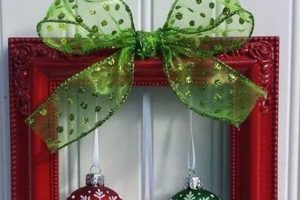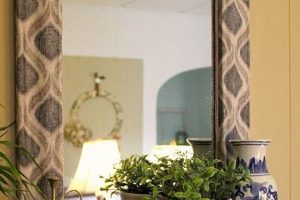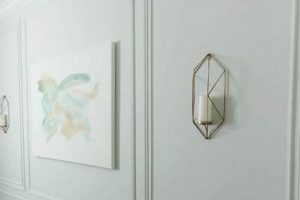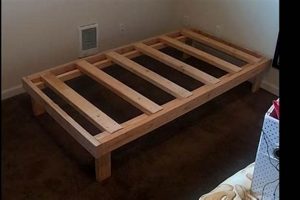A three-dimensional display case utilized to showcase cherished mementos alongside photographic prints is often constructed at home. Such enclosures, typically deeper than standard picture holders, provide space for arranging artifacts, creating personalized visual narratives. Examples include housing wedding keepsakes, preserving travel souvenirs, or exhibiting miniature collections alongside corresponding photographs.
The creation of customized display units offers a versatile means of preserving memories and adding a personal touch to interior dcor. Historically, such practices allowed individuals to curate and exhibit personal narratives, preserving experiences and facilitating storytelling through tangible objects. The process empowers individuals to exercise creative control, resulting in unique and meaningful artwork.
The subsequent sections will delve into the materials required, the construction techniques involved, and the diverse creative possibilities achievable through such an endeavor. Further exploration will address design considerations and presentation strategies for optimally showcasing the enclosed items.
Crafting Superior Display Enclosures
The construction of durable and aesthetically pleasing display enclosures requires careful consideration of materials and techniques. These tips aim to guide the creation of professional-quality pieces suitable for showcasing valued items.
Tip 1: Material Selection is Paramount: Choose wood species based on durability and aesthetic properties. Hardwoods, such as oak or maple, offer superior strength for larger structures, while softer woods, like pine, are suitable for smaller, less structurally demanding projects. Consider archival-quality backing boards to protect sensitive items from degradation.
Tip 2: Precision Cutting is Crucial: Accurate measurements and cuts are essential for creating tight-fitting joints and a professional appearance. Employ a miter saw or table saw for precise angle cuts and consistent sizing. Utilize clamps during assembly to ensure squareness and prevent warping.
Tip 3: Adhesion Techniques Matter: Select adhesives appropriate for the chosen materials. Wood glue provides a strong bond for wooden frames, while specialized adhesives may be necessary for adhering fabric or other decorative elements. Ensure adequate drying time for optimal bonding strength.
Tip 4: Glazing Considerations are Vital: Opt for UV-protective glass or acrylic to shield items from fading and degradation caused by ultraviolet light. Acrylic offers shatter resistance, while glass provides superior clarity. Secure glazing with appropriate fasteners or glazing points.
Tip 5: Backing Board Security is Key: Secure the backing board with brads, screws, or flexible tabs to ensure items remain in place. Consider using acid-free foam core to provide a neutral and protective backing for delicate artifacts.
Tip 6: Finishing Touches Enhance Aesthetics: Apply a sealant, stain, or paint to protect the wood and enhance its appearance. Ensure the finish is fully cured before placing items inside to prevent off-gassing and potential damage.
Tip 7: Secure Mounting Hardware: Employ sturdy D-rings or wire for secure wall mounting. Select hardware rated for the weight of the finished piece, including the items it will contain.
Adhering to these guidelines results in the creation of professionally constructed display enclosures, providing both aesthetic appeal and long-term protection for treasured items.
The following sections will further explore specific design ideas and inspirational projects, demonstrating the versatility of this craft.
1. Material selection
Material selection constitutes a foundational element in the creation of a display case, directly influencing its longevity, aesthetic properties, and the preservation of enclosed items. The composition of the frame, backing, and glazing each presents unique considerations directly tied to the overall quality and purpose of the finished product. For instance, the selection of acid-free backing board directly impacts the preservation of delicate documents or photographs, preventing discoloration and degradation over time. Similarly, the choice between glass and acrylic for glazing affects both the clarity of the display and its resistance to physical damage.
An example is the use of hardwood such as oak or maple versus softwood like pine. Hardwoods offer greater structural integrity for larger or heavier display cases, minimizing warping and ensuring long-term stability. However, softwoods may be preferred for smaller, lighter projects due to their lower cost and ease of workability. In cases where valuable textiles or artwork are displayed, UV-protective glazing is essential to mitigate fading caused by prolonged exposure to sunlight. In contrast, for displays in high-traffic areas, shatter-resistant acrylic may be a more practical choice, prioritizing safety over absolute optical clarity.
Therefore, informed material selection is paramount in the successful completion of a customized display enclosure. Neglecting these considerations can lead to premature degradation of displayed items, structural failures, or an overall diminished aesthetic quality. Understanding the specific properties of various materials and their impact on the finished piece is crucial for maximizing both the visual appeal and the archival value of the display.
2. Dimensional Accuracy
Dimensional accuracy constitutes a critical determinant in the success of any self-assembled display enclosure. Precise measurements and adherence to specified dimensions directly impact structural integrity, aesthetic appeal, and the overall functionality of the finished piece. Discrepancies in size can lead to misaligned joints, instability, and an inability to properly secure enclosed items.
- Frame Component Alignment
Accurate cutting and assembly of frame components ensure proper alignment and structural stability. Misaligned corners or uneven edges detract from the visual appeal and compromise the frame’s ability to support its contents. An example involves the creation of a mitered corner joint; deviations from the precise 45-degree angle result in gaps and a weakened connection. Correct measurements are thus critical for a professionally finished frame.
- Backing Board Fit
A properly sized backing board is essential for securing items within the enclosure. If the backing is too small, items may shift or fall out. If it is too large, it can create bulges or distort the frame. This often arises when constructing from reclaimed materials, where pre-existing dimensions must be carefully accounted for. Precise measurement ensures the backing board fits snugly within the frame, providing a secure and stable platform for displayed items.
- Glazing Installation
Accurate dimensions are vital for proper glazing installation. Glass or acrylic panels must fit snugly within the frame to prevent movement and ensure a secure seal. Oversized panels may require forceful fitting, potentially cracking the glazing or damaging the frame. Undersized panels will shift, compromising the protective seal and aesthetic integrity. Careful measurement and cutting are essential for a seamless and professional-looking glazing installation. Consider the expansion and contraction of materials due to temperature changes.
- Depth Consistency
Maintaining dimensional accuracy in the depth of the enclosure is crucial for accommodating the intended contents. Insufficient depth may prevent closure or cause items to press against the glazing. Excessive depth may create an unnecessarily bulky appearance. Prior to construction, accurate measurement of the largest item to be displayed is essential for determining the optimal depth. Consistency in depth, achieved through precise construction techniques, ensures a visually appealing and functional display.
In summary, meticulous attention to dimensional accuracy is paramount when constructing a display enclosure. Precise measurements and adherence to specifications are not merely aesthetic considerations but fundamental to the structural integrity, functionality, and long-term preservation capabilities of the finished piece. Prioritizing accuracy during the construction process ensures a professional-quality product that effectively showcases and protects valued items.
3. Adhesive Strength
Adhesive strength is a critical factor influencing the structural integrity and longevity of a self-constructed display case. The proper selection and application of adhesives directly correlate with the overall durability and visual appeal of the finished piece, safeguarding the enclosed artifacts against damage and degradation.
- Joint Integrity
The adhesive utilized in joining frame components dictates the strength and stability of the entire structure. Weak adhesives can lead to joint separation, warping, and ultimately, structural failure. Examples include using wood glue for mitered corner joints, where insufficient bonding leads to gaps and a compromised frame. The choice of adhesive must match the materials being joined and the expected load.
- Backing Board Attachment
Securing the backing board requires an adhesive capable of maintaining a strong bond under varying environmental conditions. Inadequate adhesion results in a loose backing, allowing dust and moisture to infiltrate the enclosure, potentially damaging the displayed items. Construction adhesive or high-strength glue may be necessary to ensure a permanent and airtight seal between the frame and the backing board.
- Glazing Security
The attachment of glazing, whether glass or acrylic, necessitates an adhesive that provides both a secure bond and compatibility with the glazing material. Incompatible adhesives can cause clouding, discoloration, or even structural damage to the glazing. Specialized glazing adhesives or silicone sealants are often employed to create a watertight and aesthetically pleasing seal, preventing movement and protecting against environmental factors.
- Embellishment Adherence
When incorporating decorative elements, such as fabric, paper, or small artifacts, the adhesive must provide a reliable bond without damaging the underlying surface. Improper adhesive selection can lead to staining, warping, or detachment of the embellishments. Acid-free glues or archival-quality adhesives are essential for preserving delicate materials and ensuring long-term adherence.
Consequently, careful consideration of adhesive strength and compatibility is paramount when assembling a display enclosure. The appropriate selection and application of adhesives are crucial for creating a structurally sound, visually appealing, and archival-quality enclosure capable of protecting and showcasing valued items for extended periods. Ignoring these factors can compromise the integrity and longevity of the entire project.
4. Glazing Clarity
Glazing clarity exerts a direct influence on the aesthetic value and preservation qualities of a display enclosure. The transparency of the glazing materialtypically glass or acrylicdictates the visibility of the displayed items, affecting the viewer’s perception and appreciation of the enclosed artifacts. Reduced clarity, whether due to imperfections in the material itself or surface contamination, diminishes the visual impact and can detract from the overall presentation.
The selection of glazing material profoundly impacts the long-term preservation of displayed items. While both glass and acrylic offer protective barriers against dust and physical damage, the clarity of the material directly affects the amount of ultraviolet (UV) light that penetrates the enclosure. UV radiation is a known catalyst for the degradation of organic materials, such as textiles, paper, and certain pigments. High-clarity glazing, particularly when combined with UV-protective coatings, minimizes this risk, preserving the integrity of displayed items for extended periods. A real-world instance involves the display of antique photographs; the use of low-clarity, non-UV protective glazing results in accelerated fading and yellowing, while high-clarity, UV-protective glazing significantly slows this process.
In summary, glazing clarity represents a crucial consideration in the design and construction of display enclosures. It’s not merely an aesthetic choice but a practical imperative for preserving the displayed items and enhancing their visual impact. The selection of high-clarity glazing, especially when combined with UV protection, contributes significantly to the longevity and overall value of the presentation, safeguarding treasured artifacts for years to come. Any imperfections in the glaze can cause distraction and detract from the image displayed.
5. Backing Support
Within the context of a self-constructed display enclosure, backing support represents a foundational element influencing both the structural integrity and the presentation quality of the finished piece. The backing, typically a rigid panel situated at the rear of the enclosure, serves as the primary platform for securing and displaying enclosed items. Inadequate backing support can lead to instability, shifting of contents, and potential damage to fragile artifacts. A direct cause-and-effect relationship exists between the quality of backing support and the longevity of displayed items.
The selection of appropriate backing materials and construction techniques is essential for achieving optimal support. Rigid materials such as wood, foam core board, or acid-free matboard are commonly employed, with the choice dictated by the size and weight of the items being displayed. Consider the example of a display enclosure designed to house a collection of heavy medals; a flimsy backing constructed from thin cardboard would likely buckle or warp over time, jeopardizing the stability of the medals. Conversely, a sturdy wooden backing would provide ample support, ensuring the medals remain securely in place. Furthermore, the method of attachmentthe use of adhesives, fasteners, or a combination thereofmust be carefully considered to prevent detachment or distortion of the backing panel. For example, using an appropriate adhesive can prevent the backing board from warping, especially in humid environments.
In conclusion, backing support is not merely a secondary consideration but an integral component of the display enclosure. Proper selection of materials, coupled with sound construction techniques, ensures the structural integrity, long-term stability, and presentation quality of the finished piece. Ignoring backing support considerations can lead to instability, damage to displayed items, and a diminished aesthetic appeal, ultimately undermining the purpose of the display enclosure. The strength and suitability of backing support is therefore essential to the structural and aesthetic success of this craft.
6. Finishing technique
The application of a finishing technique directly influences the aesthetic appeal, protective qualities, and long-term durability of a self-constructed display enclosure. This process, involving the application of paints, stains, sealants, or varnishes, extends beyond mere visual enhancement; it constitutes a critical safeguard against environmental factors that can degrade the underlying materials and compromise the integrity of the enclosed items. The choice of finishing technique and the specific products employed significantly impact the overall value and longevity of the display piece.
Consider the construction of a wooden display enclosure intended to house delicate textiles. Without a protective finish, the wood would be susceptible to moisture absorption, leading to warping, cracking, and potential fungal growth. Furthermore, the exposed wood could leach acids that damage the textiles. The application of a sealant or varnish creates a barrier against moisture, preventing these detrimental effects. Similarly, a UV-protective finish minimizes fading and discoloration caused by sunlight exposure. Another example involves a metal frame where rust is a major concern; proper priming and painting can prevent corrosion and extend the lifespan of the metal. The application of a finishing technique is therefore not optional, but an essential step in ensuring the display enclosure provides adequate protection and maintains its visual appeal over time. Different finishes offer varied degrees of protection and possess distinct aesthetic characteristics. For instance, a glossy finish provides a high level of reflectivity and highlights surface details, while a matte finish offers a more subdued and natural appearance. The selection of the appropriate finish should align with the overall design aesthetic and the specific preservation requirements of the enclosed items.
In conclusion, the finishing technique employed in the construction of a display enclosure directly impacts its aesthetic qualities, protective capabilities, and long-term durability. It represents a crucial step in the creation of a high-quality and enduring display piece, safeguarding treasured artifacts and enhancing their visual presentation for years to come. Choosing the appropriate finish extends the life of the enclosure and the objects that are stored within.
7. Mounting Security
The secure attachment of a self-constructed display enclosure represents a paramount consideration in ensuring the safety of both the display unit and its contents. Adequate mounting mechanisms mitigate the risk of accidental falls, which can result in damage to the enclosure, its contents, and potentially, injury to individuals in the vicinity. Therefore, a comprehensive understanding of mounting hardware and installation techniques is crucial for any such project.
- Weight Assessment and Hardware Selection
The initial step in ensuring mounting security involves accurately assessing the total weight of the filled display enclosure. This weight determines the appropriate type and size of mounting hardware to be employed. For instance, lightweight enclosures may be adequately supported by D-rings and picture wire, while heavier units necessitate the use of robust brackets or cleats. Selecting hardware with a weight rating exceeding the actual weight of the enclosure provides an additional margin of safety. Failure to accurately assess the weight and select appropriately rated hardware increases the risk of mounting failure.
- Wall Structure and Anchor Selection
The composition of the wall to which the display enclosure is to be mounted significantly influences the choice of anchors. Drywall, plaster, and masonry walls each require different types of anchors to ensure a secure and stable attachment. For drywall, self-drilling anchors or toggle bolts may be suitable, while masonry walls necessitate the use of expansion anchors or concrete screws. Proper anchor selection, coupled with correct installation techniques, ensures that the mounting hardware is firmly anchored to the wall structure, preventing pull-out or loosening over time. Consideration must be given to the presence of studs, which offer significantly greater support than hollow wall sections.
- Installation Techniques and Best Practices
Correct installation of mounting hardware is critical for achieving optimal security. This includes drilling pilot holes of the appropriate size, using a level to ensure the enclosure is mounted straight, and tightening fasteners to the recommended torque. Over-tightening can strip screws or damage the wall, while under-tightening can result in a loose or unstable mounting. Furthermore, the spacing and arrangement of mounting hardware should be carefully considered to distribute the load evenly and prevent stress concentrations. Adherence to established best practices, such as consulting manufacturer’s instructions and seeking professional assistance when necessary, enhances the safety and reliability of the mounting system.
- Periodic Inspection and Maintenance
Even with proper hardware selection and installation, periodic inspection and maintenance are essential for maintaining mounting security over time. This includes visually inspecting mounting hardware for signs of corrosion, loosening, or damage. Any loose screws or anchors should be tightened or replaced as needed. Furthermore, the enclosure itself should be checked for signs of warping or structural deterioration that could compromise the mounting system. Proactive maintenance ensures that the mounting system remains secure and prevents potential accidents.
In summary, mounting security represents a critical aspect of any self-constructed display enclosure project. By carefully assessing the weight of the enclosure, selecting appropriate mounting hardware and anchors, employing correct installation techniques, and conducting periodic inspections, the risk of mounting failure can be significantly reduced, ensuring the safety of the display unit, its contents, and the surrounding environment. Ignoring these considerations can have damaging consequences and should be avoided.
DIY Shadow Box Picture Frame
The following section addresses common inquiries and potential misconceptions regarding the construction and utilization of customized display enclosures. The information presented aims to provide clarity and guidance for individuals undertaking such projects.
Question 1: What constitutes the ideal depth for a customized display enclosure?
The optimal depth is determined by the dimensions of the items intended for display. Measure the thickest object to be included and add at least 1/2 inch to ensure adequate clearance. Insufficient depth may damage the contents or prevent closure, while excessive depth detracts from the visual appeal.
Question 2: What methods should be employed to prevent fading of displayed items?
Ultraviolet (UV) light is a primary cause of fading and degradation. Utilize UV-protective glass or acrylic glazing, archival-quality backing materials, and avoid placing the display in direct sunlight. Consider museum-grade glazing for particularly sensitive items.
Question 3: Is it feasible to incorporate lighting into a display enclosure?
Yes, but precautions must be taken to avoid heat damage or discoloration. LED lighting is recommended due to its low heat output and long lifespan. Ensure adequate ventilation to prevent heat buildup within the enclosure.
Question 4: How should delicate or irregularly shaped items be secured within the enclosure?
Employ archival-quality adhesives, such as acid-free glue dots or mounting putty, for temporary or semi-permanent attachment. Custom-cut foam inserts provide secure support for irregularly shaped objects. Avoid using materials that may react chemically with the displayed items.
Question 5: What type of wood is most suitable for constructing the frame?
Hardwoods, such as oak or maple, offer superior strength and durability, particularly for larger enclosures. Softwoods, like pine, are suitable for smaller projects but require careful handling to prevent dents and scratches. Ensure the wood is properly seasoned to minimize warping.
Question 6: How can dust accumulation within the display enclosure be minimized?
Ensure a tight seal between the frame, glazing, and backing. Apply weather stripping or sealant to any gaps. Consider incorporating a desiccant to absorb moisture and prevent mold growth. Periodically clean the exterior of the enclosure with a soft, lint-free cloth.
In conclusion, constructing a quality display enclosure necessitates careful planning, material selection, and attention to detail. Adhering to these guidelines will maximize the longevity and aesthetic appeal of the finished piece.
The subsequent section will explore advanced design techniques and customization options.
DIY Shadow Box Picture Frame
The preceding sections have explored the various facets of crafting display enclosures. From material selection and dimensional accuracy to adhesive strength, glazing clarity, backing support, finishing techniques, and mounting security, each element plays a crucial role in the creation of a durable, aesthetically pleasing, and archival-quality display unit. These components are crucial to consider when creating a do it yourself shadow box picture frame.
The creation of a customized display enclosure presents an opportunity to preserve cherished memories and showcase treasured artifacts. The investment in time and resources yields a tangible and enduring testament to personal history and artistic expression. Continued exploration and refinement of these techniques will undoubtedly lead to innovative approaches in the art of preservation and presentation.


![Build a Strong DIY Boxing Bag Frame [Project Guide] The DIY Hub: Creative Crafts, Repairs & Life Hacks Build a Strong DIY Boxing Bag Frame [Project Guide] | The DIY Hub: Creative Crafts, Repairs & Life Hacks](https://craftingdiycenter.com/wp-content/uploads/2025/07/th-2040-300x200.jpg)




